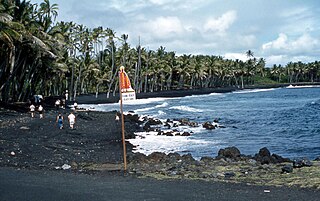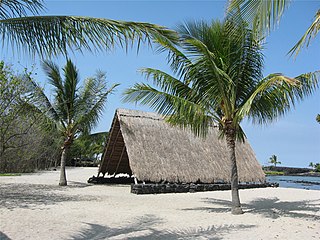
Hula is a Hawaiian dance form expressing chant (oli) or song (mele). It was developed in the Hawaiian Islands by the Native Hawaiians who settled there. The hula dramatizes or portrays the words of the oli or mele in a visual dance form.

Kaimū was a small town in the Puna District on Island of Hawaiʻi that was completely destroyed by an eruptive flow of lava from the Kūpaʻianahā vent of the Kīlauea volcano in 1990. In Hawaiian, kai mū means "gathering [at the] sea" as to watch surfing. The lava flow that destroyed Kaimū and nearby Kalapana erupted from the southeast rift zone of Kīlauea.

ʻIolani Barracks, or hale koa in Hawaiian, was built in 1870, designed by the architect Theodore Heuck, under the direction of King Lot Kapuaiwa. Located directly adjacent to ʻIolani Palace in downtown Honolulu, it housed about 80 members of the monarch's Royal Guard until the overthrow of the Monarchy in 1893. It was added to the National Register of Historic Places in 1978 as part of the Hawaii Capital Historic District.

The Makahiki season is the ancient Hawaiian New Year festival, in honor of the god Lono of the Hawaiian religion.

Kamaʻāina is a word describing Hawaii residents regardless of their racial background, as opposed to kanaka which means a person of Native Hawaiian ancestry. A kamaʻāina may be considered to be someone who lives in Hawaii, or may be expanded to include people who once lived there but have moved away.

Kalihi is a neighborhood of Honolulu on the island of Oʻahu in Hawaiʻi, United States. Split by Likelike Highway, it is flanked by Liliha, Chinatown, and Downtown Honolulu to the east and Mapunapuna, Moanalua, and Salt Lake to the west.

Kaloko-Honokōhau National Historical Park is a United States National Historical Park located in the Kona District on the Big island of Hawaiʻi in the U.S. state of Hawaiʻi. It includes the National Historic Landmarked archaeological site known as the Honokōhau Settlement. The park was established on November 10, 1978, for the preservation, protection and interpretation of traditional native Hawaiian activities and culture.

Fagraea berteroana, commonly known as the pua keni keni, pua kenikeni or perfume flower tree, is a small spreading tree or a large shrub. It is known as the pua-lulu in the Samoan Islands, and as pua in Tonga and Tahiti.

Pulu is a silky material obtained from the fibers of the hapuʻu pulu, a tree fern of Hawaii. It is made of the brown hairs that cover the young fiddlehead as it uncoils.

Kēōkea is an unincorporated populated place in Hawaiʻi County, Hawaii, United States. It is located at 19°25′10″N155°52′58″W, near the junction of Māmalahoa Highway and Keala o Keawe Road, elevation 960 feet (290 m). Satellite imagery shows evidence of a humid climate with agriculture dominant around the settlement. Just to the north is the area of Hōnaunau. It was the name for the land division (ahupuaʻa) of ancient Hawaiʻi that stretched from the shoreline to Mauna Loa owned by Mataio Kekūanaōʻa.

Samuel Mahuka Spencer was a Hawaiʻi island politician.

Kamani Helekunihi Hill is an American former professional soccer player who played as a forward or winger.

Makana is a mountain located on northern shore of the island of Kauaʻi, where it rises 1,115 feet (340 m) above Limahuli Valley. Makana is a Hawaiian language term meaning gift or reward. It is often used as a person's name or as part of a name. Limahuli Garden and Preserve preserves the valley below. It was featured in the 1958 film adaptation of the musical South Pacific as Bali Haʻi and is known by that name.
Lauhala, lau meaning "leaf" in the Hawaiian language, refers to the leaves of the hala tree (Pandanus tectorius).

The Hawaiian flagtails are species of the genus of flagtail fishes found in the Hawaiian Islands. Two species are Kuhlia sandvicensis and K. xenura. K. xenura is endemic to the islands.
Kamanawa II known as Kamanawa ʻŌpio or Kamanawa ʻElua was a Hawaiian high chief and grandfather of the last two ruling monarchs of the Kingdom of Hawaii, King David Kalākaua and Queen Lydia Makaeha Liliʻuokalani. His family had a good reputation until 1840, when he was convicted of murdering his wife.

Rainbow (Waiānuenue) Falls is a waterfall located in Hilo, Hawaii. It is 80 ft (24 m) tall and almost 100 ft (30 m) in diameter. The falls are part of the Hawai'i State Parks. There is no fee to see the falls.
Kokomo is a community on the island of Maui, Maui County, Hawaii. It is located just north of Makawao, Hawaii at 20°52′12″N156°18′32″W. Elevation is about 1,467 feet (447 m). It is uphill of the area known as Haʻikū. Contrary to popular belief, the Beach Boys' 1988 single of the same name is not based on this Hawaiian community; the song's lyrics refer instead to a fictional island near the Florida Keys.
Hoʻolauleʻa is a Hawaiian celebration or festival. A Hoʻolauleʻa may consist of authentic hula dancing and music, foods, vendors and games.

Cibotium glaucum, the hāpu‘u pulu, is a species of fern in the family Cyatheaceae, native to Hawaii. A slow-growing tree fern typically 6 to 10 ft tall but reaching 25 ft (8 m), it is hardy in USDA zones 10 through 12. Its fiddleheads are the source of the material pulu, which means "mulch" or "padding" in the Hawaiian language. Women used pulu as an absorbent during their menstrual cycles.















